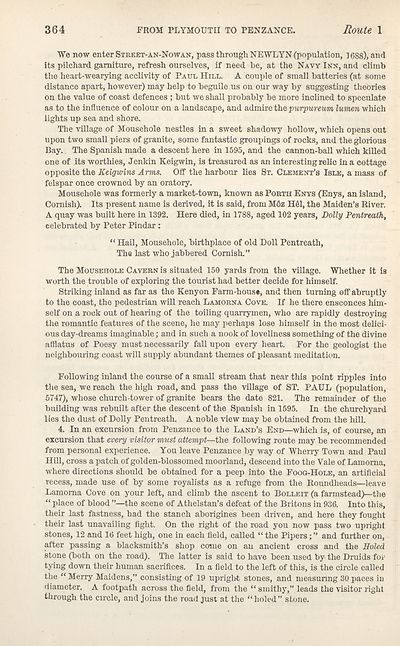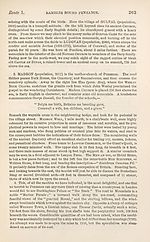Download files
Complete book:
Individual page:
Thumbnail gallery: Grid view | List view

364
FROM PLYMOUTH TO PENZANCE.
Route 1
We now enter Steeet-an-Nowan, pass through NEWLYN (population, ] 688), and
its pilchard garniture, refresh ourselves, if need he, at the Navy Inn, and climb
the heart-wearying acclivity of Paul Hill. A couple of small batteries (at some
distance apart, however) may help to beguile us on our way by suggesting theories
on the value of coast defences ; but we shall probably be more inclined to speculate
as to the influence of colour on a landscape, and admire the purpureum lumen which
lights up sea and shore.
The village of Mousehole nestles in a sweet shadowy hollow, which opens out
Upon two small piers of granite, some fantastic groupings of rocks, and the glorious
Bay. The Spanish made a descent here in 1595, and the cannon-ball which killed
one of its worthies, Jenkin Keigwin, is treasured as an interesting relic in a cottage
opposite the Keigwins Arms. Off the harbour lies St. Clement’s Isle, a mass of
felspar once crowned by an oratory.
Mousehole was formerly a market-town, known as Forth Enys (Enys, an island,
Cornish). Its present name is derived, it is said, from Mdz Hel, the Maiden’s River.
A quay was built here in 1392. Here died, in 1788, aged 102 years, Dolly Pentreath,
celebrated by Peter Pindar:
“ Hail, Mousehole, birthplace of old Doll Pentreath,
The last who jabbered Cornish.”
The Mousehole Cavern is situated 150 yards from the village. Whether it is
worth the trouble of exploring the tourist had better decide for himself.
Striking inland as far as the Kenyon Farm-house, and then turning off abruptly
to the coast, the pedestrian will reach Lamorna Cove. If he there ensconces him¬
self on a rock out of hearing of the toiling quarrymen, who are rapidly destroying
the romantic features of the scene, he may perhaps lose himself in the most delici¬
ous day-dreams imaginable; and in such a nook of loveliness something of the divine
afflatus of Poesy must necessarily fall upon every heart. For the geologist the
neighbouring coast will supply abundant themes of pleasant meditation.
Following inland the course of a small stream that near this point ripples into
the sea, we reach the high road, and pass the village of ST. PAUL (population,
5747), whose church-tower of granite bears the date 821. The remainder of the
building was rebuilt after the descent of the Spanish in 1595. In the churchyard
lies the dust of Dolly Pentreath. A noble view may be obtained from the hill.
4. In an excursion from Penzance to the Land’s End—which is, of course, an
excursion that every visitor must attempt—the following route may be recommended
from personal experience. You leave Penzance by way of Wherry Town and Paul
Hill, cross a patch of golden-blossomed moorland, descend into the Vale of Lamoma,
where directions should be obtained for a peep into the Fooq-Hole, an artificial
recess, made use of by some royalists as a refuge from the Roundheads—leave
Lamoma Gove on your left, and climb the ascent to Bolleit (a farmstead)—the
“ place of blood ”—the scene of Athelstan’s defeat of the Britons in 936. Into this,
their last fastness, had the stanch aborigines been driven, and here they fought
their last unavailing fight. On the right of the road you now pass two upright
stones, 12 and 16 feet high, one in each field, called “ the Pipers; ” and further on,
after passing a blacksmith’s shop come on au ancient cross and the Holed
stone (both on the road). The latter is said to have been used by the Draids for
tying down their human sacrifices. In a field to the left of this, is the circle called
the “ Merry Maidens,” consisting of 19 upright stones, and measuring 30 paces in
diameter. A footpath across the field, from the “ smithy,” leads the visitor right
through the circle, and joins the readjust at the “holed” stone.
FROM PLYMOUTH TO PENZANCE.
Route 1
We now enter Steeet-an-Nowan, pass through NEWLYN (population, ] 688), and
its pilchard garniture, refresh ourselves, if need he, at the Navy Inn, and climb
the heart-wearying acclivity of Paul Hill. A couple of small batteries (at some
distance apart, however) may help to beguile us on our way by suggesting theories
on the value of coast defences ; but we shall probably be more inclined to speculate
as to the influence of colour on a landscape, and admire the purpureum lumen which
lights up sea and shore.
The village of Mousehole nestles in a sweet shadowy hollow, which opens out
Upon two small piers of granite, some fantastic groupings of rocks, and the glorious
Bay. The Spanish made a descent here in 1595, and the cannon-ball which killed
one of its worthies, Jenkin Keigwin, is treasured as an interesting relic in a cottage
opposite the Keigwins Arms. Off the harbour lies St. Clement’s Isle, a mass of
felspar once crowned by an oratory.
Mousehole was formerly a market-town, known as Forth Enys (Enys, an island,
Cornish). Its present name is derived, it is said, from Mdz Hel, the Maiden’s River.
A quay was built here in 1392. Here died, in 1788, aged 102 years, Dolly Pentreath,
celebrated by Peter Pindar:
“ Hail, Mousehole, birthplace of old Doll Pentreath,
The last who jabbered Cornish.”
The Mousehole Cavern is situated 150 yards from the village. Whether it is
worth the trouble of exploring the tourist had better decide for himself.
Striking inland as far as the Kenyon Farm-house, and then turning off abruptly
to the coast, the pedestrian will reach Lamorna Cove. If he there ensconces him¬
self on a rock out of hearing of the toiling quarrymen, who are rapidly destroying
the romantic features of the scene, he may perhaps lose himself in the most delici¬
ous day-dreams imaginable; and in such a nook of loveliness something of the divine
afflatus of Poesy must necessarily fall upon every heart. For the geologist the
neighbouring coast will supply abundant themes of pleasant meditation.
Following inland the course of a small stream that near this point ripples into
the sea, we reach the high road, and pass the village of ST. PAUL (population,
5747), whose church-tower of granite bears the date 821. The remainder of the
building was rebuilt after the descent of the Spanish in 1595. In the churchyard
lies the dust of Dolly Pentreath. A noble view may be obtained from the hill.
4. In an excursion from Penzance to the Land’s End—which is, of course, an
excursion that every visitor must attempt—the following route may be recommended
from personal experience. You leave Penzance by way of Wherry Town and Paul
Hill, cross a patch of golden-blossomed moorland, descend into the Vale of Lamoma,
where directions should be obtained for a peep into the Fooq-Hole, an artificial
recess, made use of by some royalists as a refuge from the Roundheads—leave
Lamoma Gove on your left, and climb the ascent to Bolleit (a farmstead)—the
“ place of blood ”—the scene of Athelstan’s defeat of the Britons in 936. Into this,
their last fastness, had the stanch aborigines been driven, and here they fought
their last unavailing fight. On the right of the road you now pass two upright
stones, 12 and 16 feet high, one in each field, called “ the Pipers; ” and further on,
after passing a blacksmith’s shop come on au ancient cross and the Holed
stone (both on the road). The latter is said to have been used by the Draids for
tying down their human sacrifices. In a field to the left of this, is the circle called
the “ Merry Maidens,” consisting of 19 upright stones, and measuring 30 paces in
diameter. A footpath across the field, from the “ smithy,” leads the visitor right
through the circle, and joins the readjust at the “holed” stone.
Set display mode to:
![]() Universal Viewer |
Universal Viewer | ![]() Mirador |
Large image | Transcription
Mirador |
Large image | Transcription
| Antiquarian books of Scotland > Adventure and adventurers > Black's guide to the counties of Dorset, Devon, & Cornwall > (405) |
|---|
| Permanent URL | https://digital.nls.uk/142591239 |
|---|
| Description | Thousands of printed books from the Antiquarian Books of Scotland collection which dates from 1641 to the 1980s. The collection consists of 14,800 books which were published in Scotland or have a Scottish connection, e.g. through the author, printer or owner. Subjects covered include sport, education, diseases, adventure, occupations, Jacobites, politics and religion. Among the 29 languages represented are English, Gaelic, Italian, French, Russian and Swedish. |
|---|

